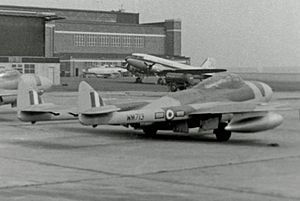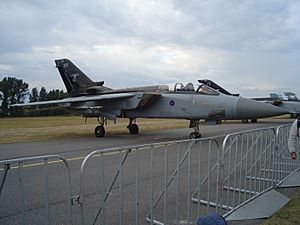No. 25 Squadron RAF facts for kids
Quick facts for kids No. XXV (F) Squadron RAF |
|
|---|---|

No. XXV (F) Squadron badge
|
|
| Active | 25 September 1915 – 31 January 1920 1 February 1920 – 23 June 1958 1 July 1958 – 30 November 1962 1 October 1963 – July 1989 July 1989 – 4 April 2008 8 September 2018 – present |
| Country | |
| Branch | |
| Part of | No. 4 Flying Training School RAF |
| Motto(s) | (Latin): Feriens tego ("Striking I defend") |
| Equipment | BAE Systems Hawk T.2 |
| Battle honours |
|
| Insignia | |
| Squadron Badge heraldry | On a gauntlet a hawk rising affrontée (The badge incorporates a previous badge used unofficially by the Squadron, the hawk being associated with the Squadron's period at RAF Hawkinge.) |
| Post 1950 squadron roundel |  |
| Squadron Codes | RX (Dec 1938 – Sep 1939) ZK (Sep 1939 – Apr 1951) FA–FZ (July 1989–Apr 2008) FA–FM (Sep 2018–present) |
Number 25 (Fighter) Squadron is a special group of aircraft and pilots in the Royal Air Force (RAF). It was formed again on September 8, 2018. This squadron has a long and interesting history.
During the First World War, No. 25 Squadron flew planes for scouting and later for bombing. Its pilots even shot down a famous German pilot named Max Immelmann. After the wars, the squadron became known for its night-fighting skills. For a while, it even operated large surface-to-air missiles. From 1989 to 2008, the squadron flew fast Tornado F.3 jets.
Today, No. 25 Squadron uses BAE Systems Hawk T.2 planes. Their main job is to provide advanced training for new pilots joining the RAF and the Royal Navy. They are part of No. 4 Flying Training School at RAF Valley.
Contents
History of No. 25 Squadron
Early Days: World War I
No. 25 Squadron began as part of the Royal Flying Corps (RFC) in Scotland on September 25, 1915. They started with different types of planes, like the Maurice Farman MF.11 Shorthorn. Soon, they received Royal Aircraft Factory F.E.2b planes.
In February 1916, the squadron moved to France. Their first job was to find and stop German planes that were trying to attack England. This didn't work very well, so they were given new tasks. They started protecting important military headquarters.
The squadron moved again to Auchel, France, and helped the British Army. They flew scouting missions and dropped bombs behind enemy lines. This was to prepare for a big battle called the Somme Offensive.
Taking Down a Famous Ace
On June 18, 1916, something very important happened. Corporal James Henry Waller and his pilot, Second Lieutenant George Reynolds McCubbin, shot down a famous German pilot. This pilot was Max Immelmann, known as the "Eagle of Lille."
Immelmann had already shot down one of their planes that day. He was flying a Fokker E.III and attacked McCubbin's F.E.2b. But Waller, who was the gunner, fired back and hit Immelmann's plane. For this brave act, McCubbin received a special medal, and Waller was promoted and also got a medal. When the Somme Offensive began, No. 25 Squadron started flying bombing missions at night. Later, in June 1917, they began using D.H.4 bombers.
During World War I, nine pilots from 25 Squadron became "flying aces." This means they shot down five or more enemy planes.
Between the World Wars
After World War I, the squadron used D.H.9s. They were temporarily closed down in January 1920 but started up again the very next day. They flew Snipes and even went to Turkey for a short time.
For many years, the squadron was based at RAF Hawkinge. This is where the hawk symbol on their squadron badge comes from. Over time, they flew different planes like the Grebe and Siskin. In 1936, they were the first to get the Hawker Fury Mk II. Later, they switched to the Hawker Demon and became a night-fighter squadron.
World War II Missions
No. 25 Squadron moved to RAF Northolt in September 1938. During World War II, they flew Blenheims for night patrols. These were later replaced by Beaufighters and then Mosquitos.
Towards the end of the war, the squadron mostly flew missions to protect bombers. They were very successful in stopping enemy planes during a German bombing campaign called Operation Steinbock in 1944.
Cold War Era: Jets and Missiles
After World War II, No. 25 Squadron continued to use Mosquito night fighters. But in 1951, they started flying jet planes, the De Havilland Vampire NF.10. These fast jets were then replaced by Gloster Meteor NF Mk.12 and 14s in 1954. The squadron moved bases and was temporarily closed down in 1958.
However, it was quickly reformed and continued to fly Meteors. In 1959, they upgraded to Gloster Javelin FAW Mk.7s.
The Bloodhound Missile
No. 25 Squadron was closed again in 1962. But a year later, it reformed with a completely new role. It became the first RAF unit to operate the Bristol Bloodhound SAM. These missiles were used to shoot down enemy aircraft from the ground.
The squadron moved to different bases, including RAF Bruggen in West Germany. They used these missiles to protect other RAF bases. In 1983, they moved back to the UK, protecting bases like RAF Barkston Heath.
Flying the Tornado F3
In October 1989, the RAF stopped using the Bloodhound missiles. No. 25 Squadron immediately reformed as a fighter squadron, flying the RAF Tornado F3 jet. They became ready for action in January 1990.
The squadron took part in Operation Deny Flight between 1993 and 1995. This was a NATO operation to enforce a "no-fly zone" over Bosnia-Herzegovina for the United Nations. They flew missions from an air base in Italy. Later, they deployed to Saudi Arabia to help protect people in southern Iraq.
From 2004 to 2005, a group of their Tornado jets went to Lithuania. They helped provide air defense for Lithuania, Latvia, and Estonia after these countries joined NATO. In the UK, the squadron's main job was "Quick Reaction Alert" (QRA). This meant they were ready to launch quickly to protect the southern UK airspace. For example, in July 2007, they intercepted several large Russian bombers. The squadron was closed down again on April 4, 2008.
Training the Next Generation of Pilots
In August 2018, it was announced that No. 25 Squadron would be reformed. This was because more fast jet pilots were needed for the RAF and the Fleet Air Arm, especially with the new F-35B Lightning jets.
The existing Hawk T.2 training squadron was split into two. No. 25 Squadron now focuses on teaching new pilots how to fly jets. This helps prepare them for advanced combat aircraft. They work alongside No. IV (AC) Squadron at No. 4 Flying Training School.
See also
- Richard Haine
- List of Royal Air Force aircraft squadrons





